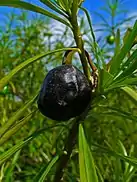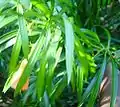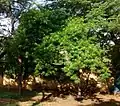Cascabela thevetia
Cascabela thevetia (syn: Thevetia peruviana) is a poisonous plant native throughout Mexico and in Central America, and cultivated widely as an ornamental. It is a relative of Nerium oleander, giving it a common name yellow oleander, and is also called lucky nut in the West Indies.
| Cascabela thevetia | |
|---|---|
 | |
| Flowers and leaves | |
| Scientific classification | |
| Kingdom: | |
| (unranked): | |
| (unranked): | |
| (unranked): | |
| Order: | |
| Family: | |
| Genus: | |
| Species: | C. thevetia |
| Binomial name | |
| Cascabela thevetia (L.) Lippold | |
| Synonyms[1] | |
| |
Etymology
'Cascabel', 'cascavel' or 'cascabela' is Spanish for a small bell, a snake's rattle or a rattlesnake itself.[2] The allusion may also be to the plant's toxicity comparable to the venom of a rattlesnake. The specific name 'thevetia' commemorates André de Thevet (1516-1590), a French Franciscan priest and explorer, who explored Brazil (where the plant is known as chapéu-de-napoleão, ie, Napoleon's hat).
Description
Cascabela thevetia is an evergreen tropical shrub or small tree. Its leaves are willow-like, linear-lanceolate, and glossy green in color. They are covered in waxy coating to reduce water loss (typical of oleanders). Its stem is green turning silver/gray as it ages.[3] Flowers bloom from summer to fall. The long funnel-shaped sometimes-fragrant yellow (less commonly apricot, sometimes white) flowers are in few-flowered terminal clusters.[3] Its fruit is deep red-black in color encasing a large seed that bears some resemblance to a 'Chinese lucky nut.'
Cascabela thevetia is commonly known as Kaneir or Kaner (कनेर) in Hindi language in India. It is effectively drought resistant and tolerant to high temperatures, hence found in various states of India like Bihar, Delhi, Gujarat, Madhya Pradesh, West Bengal, Rajasthan, Tamil Nadu and Uttar Pradesh where semi arid climate is prevalent.
Religious importance
Its bright yellow flowers are used for religious purposes, especially in the worshipping of the Hindu deity Vishnu.
Toxicity

All parts of the C. thevetia plant are toxic to most vertebrates as they contain cardiac glycosides. Many cases of intentional and accidental poisoning of humans are known.[4]
The main toxins are the cardenolides called thevetin A and thevetin B; others include peruvoside, neriifolin, thevetoxin and ruvoside.[5][6] These cardenolides are not destroyed by drying or heating and they are very similar to digoxin from Digitalis purpurea. They produce gastric and cardiotoxic effects. Antidotes for treatment include atropine and digoxin immune fabs (antibodies) and treatment may include oral administration of activated charcoal.[7][8][9] Ovine polyclonal anti-digitoxin Fab fragment antibody (DigiTAb; Therapeutic Antibodies Inc.) can be used to treat T. peruviana poisoning, but for many countries the cost is prohibitive.[10]
A few bird species are however known to feed on them without any ill effects. These include the sunbirds, Asian koel, red-whiskered bulbul, white-browed bulbul, red-vented bulbul, brahminy myna, common myna and common grey hornbill.[11][12][13][14][15][16]
In South India and in Sri Lanka swallowing the seeds of Thevetia peruviana (Kaneru කණේරු (Sinhala), Manjal arali(Tamil) ) is one of the preferred methods for suicides in villages where they are grown in abundance.[17]
Extracts from C. thevetia are reported to possess antispermatogenic activity in rats.[18]
Uses
_trunk_in_Kolkata_W_IMG_8009.jpg.webp)
- Cultivation
Cascabela thevetia is cultivated as an ornamental plant, and planted as large flowering shrub or small ornamental tree standards in gardens and parks in temperate climates. In frost prone areas it is container plant, in the winter season brought inside a greenhouse or as a house plant. It tolerates most soils and is drought tolerant.[3]
- Biological pest control
The plant's toxins have tested in experiments for uses in biological pest control. T. peruviana seed oil was used to make a 'paint' with antifungal, antibacterial and anti-termite properties.[19]
Gallery
 Apricot colored flower
Apricot colored flower Seeds
Seeds Dry seeds
Dry seeds Leaves
Leaves White variety of Cascabela thevetia
White variety of Cascabela thevetia.jpg.webp) Growth habit
Growth habit Variety with apricot-colored flowers.
Variety with apricot-colored flowers. At a park in Delhi, India
At a park in Delhi, India Cascabela thevetia (Kaner) in Delhi
Cascabela thevetia (Kaner) in Delhi_in_Rajkot.jpg.webp) Cascabela thevetia (Karen) in Rajkot
Cascabela thevetia (Karen) in Rajkot
References
- "The Plant List: A Working List of All Plant Species". Retrieved May 17, 2014.
- Quattrocchi, Umberto (1999). CRC World Dictionary of Plant Names: Common Names, Scientific Names, Eponyms, Synonyms, and Etymology. CRC Press. ISBN 9780849326738.
- "Thevetia peruvians". Missouri Botanical Garden. Archived from the original on 2004-12-09. Retrieved 2011-04-19.
- Shannon D. Langford & Paul J. Boor (1996). "Oleander toxicity: an examination of human and animal toxic exposures". Toxicology. 109 (1): 1–13. doi:10.1016/0300-483X(95)03296-R. PMID 8619248.
- Bose TK, Basu RK, Biswas B, De JN, Majumdar BC, Datta S (1999). "Cardiovascular effects of yellow oleander ingestion". J Indian Med Assoc. 97 (10): 407–410. PMID 10638101.
- Kohls S, Scholz-Böttcher BM, Teske J, Zark P, Rullkötter J (2012). "Cardiac glycosides from Yellow Oleander (Thevetia peruviana) seeds". Phytochemistry. 75: 114–27. doi:10.1016/j.phytochem.2011.11.019. PMID 22196940.
- Rajapakse S. (2009). "Management of yellow oleander poisoning". Clinical Toxicology. 47 (3): 206–212. doi:10.1080/15563650902824001. PMID 19306191. S2CID 37334350.
- Roberts D.M.; Southcott E.; Potter J.M.; Roberts M.S.; Eddleston M.; Buckley N.A. (2006). "Pharmacokinetics of digoxin cross-reacting substances in patients with acute yellow oleander (Thevetia peruviana) poisoning, including the effect of activated charcoal". Therapeutic Drug Monitoring. 28 (6): 784–792. doi:10.1097/ftd.0b013e31802bfd69. PMC 2296884. PMID 17164695.
- Bandara V.; Weinstein S.A.; White J.; Eddleston M. (2010). "A review of the natural history, toxinology, diagnosis and clinical management of Nerium oleander (common oleander) and Thevetia peruviana (yellow oleander) poisoning". Toxicon. 56 (3): 273–281. doi:10.1016/j.toxicon.2010.03.026. PMID 20438743.
- M. Eddleston; S. Rajapakse; Rajakanthan, S. Jayalath; L. Sjöström; W. Santharaj; et al. (2000). "Anti-digoxin Fab fragments in cardiotoxicity induced by ingestion of yellow oleander: a randomised controlled trial". Lancet. 355 (9208): 967–972. doi:10.1016/S0140-6736(00)90014-X. PMID 10768435. S2CID 2095538.
- Kannan,R (1991). "Koels feeding on the yellow oleander". Blackbuck. 7 (2): 48.
- Krishnan, M (1952). "Koels (Eudynamis scolopaceus) eating the poisonous fruit of the Yellow Oleander". J. Bombay Nat. Hist. Soc. 50 (4): 943–945.
- Raj,PJ Sanjeeva (1963). "Additions to the list of birds eating the fruit of Yellow Oleander (Thevetia neriifolia )". J. Bombay Nat. Hist. Soc. 60 (2): 457–458.
- Raj, P J Sanjeeva (1959). "Birds eating poisonous fruit of Yellow Oleander (Thevetia neriifolia)". J. Bombay Nat. Hist. Soc. 56 (3): 639.
- Neelakantan,KK (1953). "Common Grey Hornbill (Tockus birostris) eating fruits of the Yellow Oleander (Thevetia neriifolia)". J. Bombay Nat. Hist. Soc. 51 (3): 738.
- Rajasingh,Simon G; Rajasingh,Irene V (1970). "Birds and mammals eating the fruits of Yellow Oleander (Thevetia peruviana)". J. Bombay Nat. Hist. Soc. 67 (3): 572–573.
- M. Eddleston, D.A. Warrell (1999-09-01). "Management of acute yellow oleander poisoning". QJM: An International Journal of Medicine. Retrieved 2018-02-20.
- Gupta R, Kachhawa JB, Gupta RS, Sharma AK, Sharma MC, Dobhal MP (March 2011). "Phytochemical evaluation and antispermatogenic activity of Thevetia peruviana methanol extract in male albino rats". Hum Fertil (Camb). 14 (1): 53–59. doi:10.3109/14647273.2010.542230. PMID 21466267. S2CID 24757302.
- Kareru P.G.; Keriko J.M.; Kenji G.M.; Gachanja A.N. (2010). "Anti-termite and antimicrobial properties of paint made from Thevetia peruviana (Pers.) Schum. oil extract". African Journal of Pharmacy and Pharmacology. 4 (2): 87–89.
External links
| Wikimedia Commons has media related to Cascabela thevetia. |